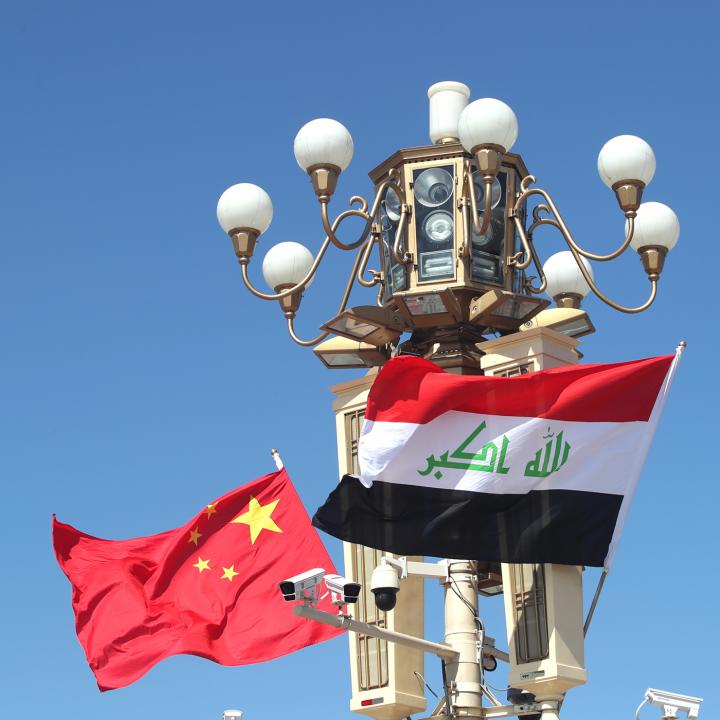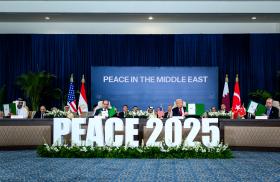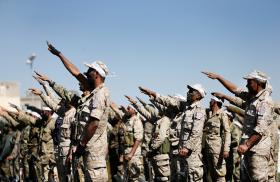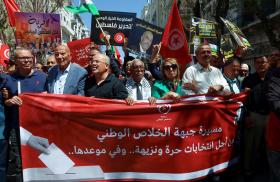
- Policy Analysis
- PolicyWatch 4052
Iraq Pledges Nuclear Cooperation with Russia and China

A cabinet minister and senior member of the Iran-backed terrorist organization Asaib Ahl al-Haq recently announced nuclear cooperation deals with two U.S. adversaries.
In the past two weeks, Naim al-Aboudi—who heads Iraq’s Atomic Energy Commission and serves as minister of higher education and scientific research—made two eyebrow-raising announcements regarding the government’s civil nuclear cooperation plans. On May 27, he mentioned a deal that Baghdad has been building with Russia since early 2024, with the aim of signing an agreement to co-develop small nuclear reactors at unspecified locations inside Iraq for electricity production. And on June 1, he noted that his commission is partnering with China’s Atomic Energy Authority to establish a subcritical “training reactor” at al-Tuwaitha nuclear industry complex just outside Baghdad. (Al-Tuwaitha’s reactor and labs were destroyed in 1981 by an Israeli airstrike, then struck again by the United States in 1991, but they have recently been certified as clear of radiological contamination.)
At first blush, seeking peaceful nuclear technology for power generation seems like a logical choice for Iraq. The country typically needs 40-50 gigawatts of electricity to meet demand in the peak summer season, but the maximum available through local generation and imports this year will likely total 28-30 gigawatts at most. In the future, as temperatures rise and the population grows, keeping up with power requirements will become even more difficult. It is also natural for Baghdad to want the same nuclear power capabilities that other regional states have, particularly given its history of advanced nuclear research. And like other major oil producers, Iraq may wish to maximize its highly profitable export of hydrocarbons while the world still runs on oil and gas, switching as much of its domestic power generation as possible to nuclear and renewables.
Yet there are wrinkles in this logic. First, as neighboring Iran has shown, transitioning from conventional to nuclear power is neither quick nor a panacea. Iraq’s deep electricity sector problems are less about power generation and more about transmission, distribution, technical losses, and unconstrained demand growth due to subsidization of state-provided electricity and nonpayment by electricity users. To bridge these gaps within the next few years, the quickest path would involve a combination of initiatives: gas capture, electricity imports, burning of readily available oil in power plants, accelerated development of renewables, and electricity sector reforms. The nuclear path would take substantially longer, even with relatively quick Chinese construction assistance.
Iraq also remains an unstable environment where nuclear industrial development could pose a bevy of risks. Although outwardly presenting as a major economy on the mend after decades of conflict, Iraq is still a governance basket case and a huge U.S. sanctions risk. The ruling coalition that appointed Prime Minister Mohammed Shia al-Sudani includes several U.S.-designated, Iran-backed terrorist organizations, and nuclear chief Aboudi is a member of one such group, Asaib Ahl al-Haq (AAH). Last month, Qais al-Khazali, the leader of AAH, reminisced about playing an “honorable” role in the 2007 deaths of five American soldiers, four of whom were abducted, handcuffed, and shot in cold blood. In 2015, Aboudi gloated about the same incident while serving as AAH’s spokesman: “It was not only these five, we killed many Americans. Every American who carried a gun is a target for us.”
Washington has not yet commented on the Chinese/Russian deals and Aboudi’s involvement in them, but it should. Indeed, U.S. and international policymakers have ample reason to view Iraq’s nuclear energy ambitions with caution. Although a single small training reactor is unlikely to pose a threat, anything more than that would raise multiple concerns.
First, the militias that essentially run Iraq have a poor record on safety, corruption, and smuggling, so trusting them to responsibly oversee nuclear infrastructure would be unwise. For example, their conventional arms depots have a lamentable history of catching fire and showering Baghdad with stray rockets. And in 2016, when Aboudi was already a senior member of AAH, the group was documented disassembling Iraq’s largest oil refinery at Bayji and shipping many of its components to Iran. (The facility had been damaged by the Islamic State before being liberated in 2015, but initial assessments indicated that it could have been repaired and put back into service.) If Baghdad embarks on a nuclear program of any scope, militias that have become accustomed to doing what they wish with the country’s resources may balk at allowing the International Atomic Energy Agency to fully enforce the requisite safeguards. (Iraq signed a safeguards agreement with the IAEA in 1972 and adopted the more restrictive Additional Protocol in 2012.)
Second, can a government controlled by Iran-backed militias be counted on not to transfer nuclear technology to and from Iran? For example, Iran has vowed to retain its uranium enrichment capabilities and could conceivably become the main and most proximal supplier of nuclear fuel to Iraq—a scenario that could create serious problems for Baghdad’s relations with Washington. Worse, Iran may try to use militia-run Iraq as a way to circumvent U.S. nuclear sanctions. To give an adjacent example, after the National Iranian Oil Company was hit with heavy sanctions, it established offices inside Iraq’s Oil Ministry, which is free from such sanctions. Since then, Iraq’s ministry has repeatedly purchased excess oil and gas equipment and transferred it to Iran. Such abuses make clear why it is so important for Washington not to repeat the error it made during Iraq’s 2022 government formation process, when U.S. officials raised no objection to a member of a designated terrorist group running key scientific and nuclear research agencies. In the lead-up to this November’s parliamentary election, Iraqi power players will begin maneuvering behind closed doors to shape the next government, so the Trump administration should ready its strategy for messaging and pressuring Baghdad sooner rather than later.
Third, the involvement of two other U.S. adversaries—Russia and China—could likewise raise complications for Iraq due to existing or future sanctions. Sudani’s government has already shown remarkable favoritism toward Beijing in the conventional energy sector, with thirteen of sixteen major contracts signed in April-May going to Chinese vendors. Regarding nuclear energy, Baghdad could (correctly) argue that the U.S. reactor industry is not currently a credible alternative to Russia and China’s robust industries. Yet that could change, and Iraq certainly has the time to wait: the government has not yet passed the necessary regulatory framework via a comprehensive, transparent nuclear power law, and it will need to work even more closely with the IAEA before implementing any nuclear initiatives.
Another potential alternative is the nuclear power consortia and fuel bank currently being discussed by various Gulf states in reference to ending Iran’s enrichment activities. If that plan comes to fruition, Iraq should be encouraged to join it instead of looking to the rogue’s gallery of Iran, Russia, and China, all of whom carry immediate sanctions risks today and potential secondary tariff risks in the future.
Michael Knights is the Bernstein Senior Fellow at The Washington Institute and co-creator of its Militia Spotlight platform.



